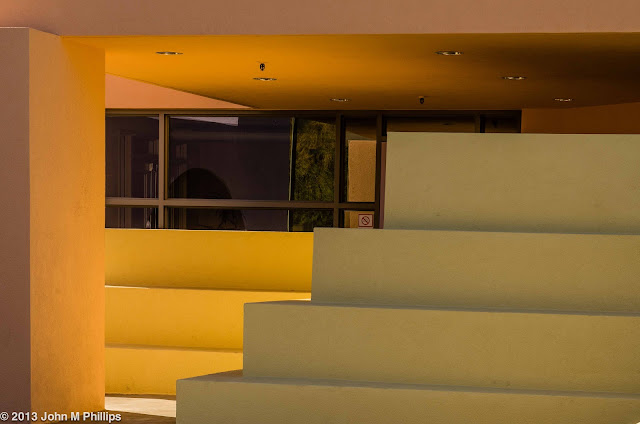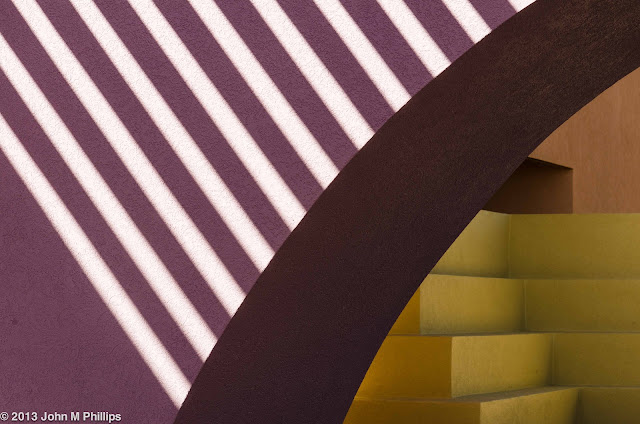I couldn't help myself. I returned to Scottsdale's Mustang Library yet again to take some more photos. I chose Sunday morning because the library was closed and I felt comfortable spending some time on other parts of the building without the distraction of other people. After I looked at what I shot, I was asking myself, What am I trying to do? For the most part, my intention was not to capture the overall building or its architecture. Instead, I was looking for abstracts, but not necessarily pure abstracts, rather, abstracts that were recognizable--what I have referred to as intelligible abstracts.
Why am so focused on abstracts? First, I am looking for something that I have control over. By closing in on abstract detail, I can generally eliminate extraneous elements that I feel will detract from the overall composition. Second, I still have the fantasy that I can to do something artistic, something that could be framed or at least that others might find interesting. Third, I simply think I can do abstracts better than broader landscape, nature, or architectural photography.
Scottsdale's Mustang Library offers all sorts of opportunities for abstracts. It is filled with complex lines and includes multiple bright colors. Bright sunshine casting sharp shadows adds to the possibilities. But the fact that the building offers ample opportunities for abstracts doesn't mean that they "work." Here is a photo of a door at the rear of the building (actually, a portion of a door).
I like the colors, but I guess I would have to ask what is the point.
Here is another shot that has, I think, a bit more interest.
This shot has more color and it helps that the lines are at contrasting angles. The dappled shadows on the back wall also add some interest.
Here are a couple of shots from the front of the building that feature some low stacked walls that appear to serve no utilitarian purpose. The first shot includes a background area that adds depth. I liked the quality of light on the underside of the exterior ceiling.
Here is another closer shot that is focused in on the lines of the stacked walls.
Although the colors create some interest, maybe it's a bit simple.
Here are shots that feature both the stacked walls and the shadows created by the sun streaming through the pergola above the main entrance to the building.
I like this first shot for its lines and simplicity. However, the violet portion is too dominant resulting in a composition that lacks balance. Besides, what's the point? Here is another shot that I feel has more balance at least.
But that six-sided bright spot is too strong and creates a distraction.
In the following shot I limited the composition to just the stripes.
OK, so this is really abstract. I'm not even sure what this is a photo of, and I'm the one that took the shot. I do like it, but there's no story. Too simple, I think.
Although the scene in the background of the following shot doesn't have the clean lines that the rest of the shot provides, the depth does help to create some sort of meaning (I think).
And the following shot also evokes some depth, though it is a bit "simple."
I have to confess that there was the branch of a tree that intruded on the lower left side of this shot and I excised it in post processing.
One side of the building featured an extensive pergola that was casting interesting shadows, and I started taking shots of the pergola itself.
I liked that the slanting streaks of light on the supporting joists extended only halfway across the image in this shot.
Then I realized that the sky could add another color to the mix.
I thought this last was the most powerful of this group of shots.
Finally, I noticed that the library was being reflected in a nearby glass-faced building.
Usually, in reflection shots, it is a challenge to keep me and my camera from appearing in the image. Here I was able to solve this problem by arranging the shot so that my reflection would have appeared in the nonreflecting portion of the wall on the right side of the image.
So what are my conclusions? Most importantly, the photo needs to be more than simply an abstract; it needs to tell a story, either through creating depth or through context. Second, the shot needs to have balance. Third, it needs to have sufficient complexity.
One more note: I had brought my tripod for this shoot, but decided that the Arizona light was bright enough that I could take the shots handheld. I was happy with the overall clarity of the shots; they are really quite crisp.




















































